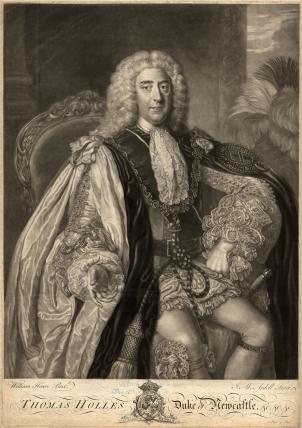In 1711, young Thomas Pelham-Holles, aged eighteen, succeeded his relative the Duke of Newcastle in estates ( although not in title) and became the possessor of thousands of acres in a dozen counties in England, enjoying a rent-roll of more than 30,000 pounds sterling a year. At twenty-one he was made Viscount and Earl and Lord Lieutenant for two counties, a year later Marquess and Duke, two years later Lord Chamberlain and Privy Councilor, and a year after that Knight of the Garter, and so on and so forth.

—John Wootton (1682 – 1764 ) from the Yale Center for British Art, Paul Mellon Collection—Read More:http://siftingthepast.com/2012/09/17/lord-portmore-watching-racehorses-at-exercise-on-newmarket-heath-john-wootton-1753/
Pelham-Holles could personally influence the election of a dozen members of Parliament. Nottinghamshire and Sussex knew him as their master. The great houses that he built or adorned-Nottingham Castle, completely remodeled, high on its cliff above the town; Haughton, his hunting lodge in the Dukeries; Claremont, his uncles vast new Vanbrugh palace for which he redesigned the landscape; the old family mansions of his father, Halland and Bishopstone, both gutted an recreated- these were the necessary symbols of his territorial greatness. Like the gold plate that loaded his table and the hordes of servants that attended him on every journey, they were necessities of his social status. Vast palaces, extravagant living, profusion in every act of life were compulsive in a world that equated wealth with power.

—Artist
by James Macardell
after William Hoare
Sitter
Thomas Pelham-Holles, 1st Duke of Newcastle-under-Lyne —Read More:http://www.npgprints.com/image/29776/james-macardell-william-hoare-thomas-pelham-holles-1st-duke-of-newcastle-under-lyne
Nor was the Duke of Newcastle exceptional. The Dukes of Bedford enjoyed an income equally large from the vast estates their ancestors had acquired from loot of the monasteries Henry VIII had destroyed. In addition, the Bedford’s acquired by judicious marriage great areas of London, principally Covent Garden and Bloomsbury. Docks at Rotherhithe cradled their own fleet of Indiamen. It is not surprising that magnates such as these should require three of four palaces ( among them the huge house at Woburn that now draws throngs of visitors and whose enormous park and chain of lakes comfortably absorb a great zoo and numerous pleasure grounds).

John Giles Eccardt, Portrait of Sir Robert Walpole and Catherine Shorter, His first Wife, ca. 1746, oil on canvas, courtesy of The Lewis Walpole Library, Yale University. Read More:http://opa.yale.edu/images/slideshow/Slideshow-Strawberry-Hill/slideshow.html
The Devonshires were richr still, and grew richer with each passing generation. Hardwick Hall, Chatsworth, Bolton Abbey, Lismore Castle and Compton Place and Devonshire House- all vast, all costly, all crammed with pictures, statuary, furniture, and teeming with servants- gave them security and comfort in their peregrinations. At one time the Dukes of Buccleuch rejoiced in eight country houses ( five gigantic) and two London houses ( both palaces).

—A founding member of the Royal Academy in 1768, Sandby was regarded as “the father of English watercolor,” and in focusing on landscapes and scenes across England, Scotland and Wales rather than Italy, he left an important record of social, economic and political change.
His subjects ranged from street hawkers to battlefields, and sweeping landscapes to grand aristocratic estates, using innovative painting techniques which he passed on to students at the Academy and amateur artists.
Exhibition organizers considered it “remarkable” that such an accomplished painter apparently had no formal training, but learned the basic skills of his trade as a military draughtsman whose early role was to make maps.
As a young man he moved to Soho in London, then the center of the art world, and had the audacity to take on Hogarth, an elder statesmen of British art, in a series of viciously satirical prints. The target of his attack was Hogarth’s 1753 book “The Analysis of Beauty,” which set out with the aim of “fixing fluctuating ideas of taste.”—Read More:http://www.original-artworks.com/the-royal-academy-show-focuses-on-neglcted-british-painter-paul-sanby/





 COMMENTS
COMMENTS